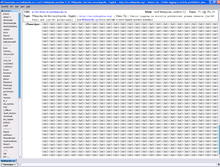The Dynamic Host Configuration Protocol (DHCP) is a network management protocol used on Internet Protocol (IP) networks for automatically assigning IP addresses and other communication parameters to devices connected to the network using a client–server architecture.

IRC is a text-based chat system for instant messaging. IRC is designed for group communication in discussion forums, called channels, but also allows one-on-one communication via private messages as well as chat and data transfer, including file sharing.
The Session Initiation Protocol (SIP) is a signaling protocol used for initiating, maintaining, and terminating communication sessions that include voice, video and messaging applications. SIP is used in Internet telephony, in private IP telephone systems, as well as mobile phone calling over LTE (VoLTE).
The Secure Shell (SSH) Protocol is a cryptographic network protocol for operating network services securely over an unsecured network. Its most notable applications are remote login and command-line execution.
Telnet is a client/server application protocol that provides access to virtual terminals of remote systems on local area networks or the Internet. It is a protocol for bidirectional 8-bit communications. Its main goal was to connect terminal devices and terminal-oriented processes.
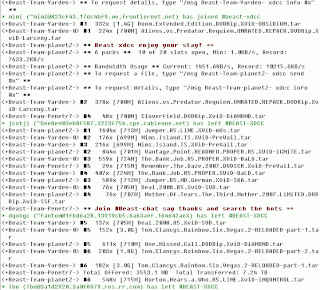
XDCC is a computer file sharing method which uses the Internet Relay Chat (IRC) network as a host service.
Direct Client-to-Client (DCC) is an IRC-related sub-protocol enabling peers to interconnect using an IRC server for handshaking in order to exchange files or perform non-relayed chats. Once established, a typical DCC session runs independently from the IRC server. Originally designed to be used with ircII it is now supported by many IRC clients. Some peer-to-peer clients on napster-protocol servers also have DCC send/get capability, including TekNap, SunshineUN and Lopster. A variation of the DCC protocol called SDCC, also known as DCC SCHAT supports encrypted connections. An RFC specification on the use of DCC does not exist.

Eggdrop is a popular IRC bot and the oldest that is still being maintained.
An IRCd, short for Internet Relay Chat daemon, is server software that implements the IRC protocol, enabling people to talk to each other via the Internet. It is distinct from an IRC bot that connects outbound to an IRC channel.
Client-to-client protocol (CTCP) is a special type of communication between Internet Relay Chat (IRC) clients.

Colloquy is an open-source IRC, SILC, ICB and XMPP client for Mac OS X. Colloquy uses its own core, known as Chat Core, although in the past it used Irssi as its IRC protocol engine. One of the primary goals behind Colloquy was to create an IRC, SILC and ICB client with Mac OS X visuals. Colloquy contains a user interface that follows Apple's Human interface guidelines in addition to containing support for traditional IRC command-line controls such as /nick and /join.
Rizon is an Internet Relay Chat (IRC) network. The IRC network itself ranks number 5 among the largest IRC networks. Rizon is popular with many anime fansubbing groups who work online, many of whom provide their content through XDCC via IRC bots in their distribution channels. It is also used by many users of eRepublik as a means of communication. File sharing of other copyrighted material such as Warez is also common in some channels on the network.
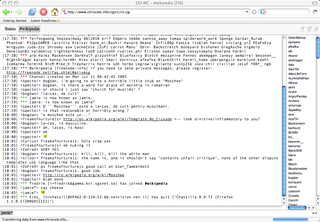
CGI:IRC is a CGI program written in Perl that allows access to IRC via a web browser. It is designed to be flexible and has many uses such as an IRC gateway for an IRC network, a chat-room for a website or to access IRC when stuck behind a restrictive firewall.
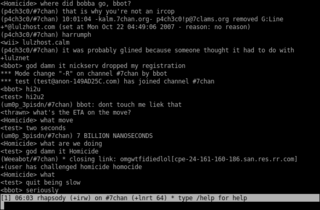
ircII is a free, open-source Unix IRC and ICB client written in C. Initially released in the late 1980s, it is the oldest IRC client still maintained.
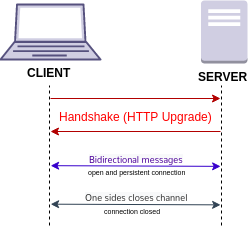
WebSocket is a computer communications protocol, providing a simultaneous two-way communication channel over a single Transmission Control Protocol (TCP) connection. The WebSocket protocol was standardized by the IETF as RFC 6455 in 2011. The current specification allowing web applications to use this protocol is known as WebSockets. It is a living standard maintained by the WHATWG and a successor to The WebSocket API from the W3C.
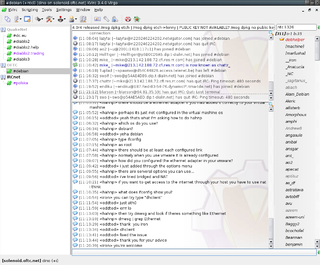
KVIrc is a graphical IRC client for Linux, Unix, Mac OS and Windows. The name is an acronym of K Visual IRC in which the K stands for a dependency to KDE, which became optional from version 2.0.0. The software is based on the Qt framework and its code is released under a modified GNU General Public License.
Plouf's Java IRC (PJIRC) is a web-based open-source IRC client that is written in Java. Any web browser that supports the Java Runtime Environment, or an alternative Java interpreter, can use the applet. Many IRC networks have a public installation of the applet for their network.
UnrealIRCd is an open-source IRC daemon, originally based on DreamForge, and is available for Unix-like operating systems and Windows. Since the beginning of development on UnrealIRCd c. May 1999, many new features have been added and modified, including advanced security features and bug fixes, and it has become a popular server.
